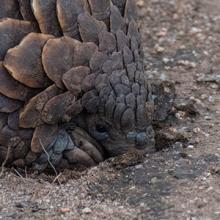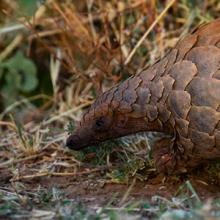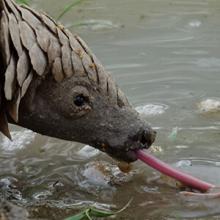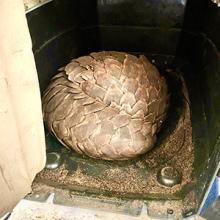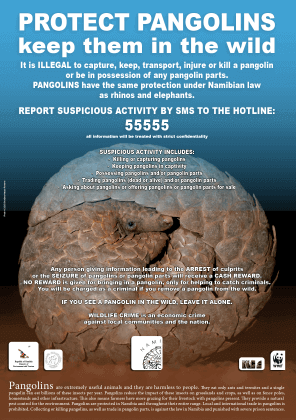
NPWG
Namibian Pangolin Working Group (NPWG)
About
The Namibian Pangolin Working Group (NPWG) was established in April 2020 as a collaborative effort between the Namibian government and non-governmental partners in response to the increasing threats faced by pangolins (Temminck’s ground pangolin Smutsia temminckii) in Namibia.

The current priorities of the NPWG are to:
- Develop and implement a concise National Conservation Management Plan for pangolin;
- Prepare and implement guidelines and protocols for the handling of confiscated pangolins by first responders, getting them quickly into rehabilitation and veterinary care, and the procedures for selecting good release sites;
- Guide priority research to better understand key areas specifically related to pangolin conservation, diet, status and release;
- Raise awareness and help educate target groups about pangolins, particularly their ecological role and importance to ecosystem functioning;
- Promote international collaboration and information sharing.
NPWG Members
Chair:
Ministry of Environment, Forestry and Tourism, represented by Kenneth /Uiseb.
Secretariat:
Kelsey Prediger nampwg@gmail.com
If you are interested in joining NPWG please contact the Secretariat. Membership is free.
Member Organisations:
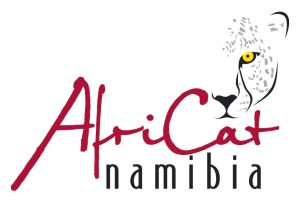
Africat Foundation
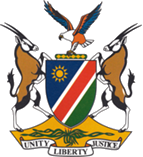
Ministry of Environment, Forestry and Tourism

Namibian Chamber of Environment

NARREC ( Liz Komen)

NUST Biodiversity Research Centre
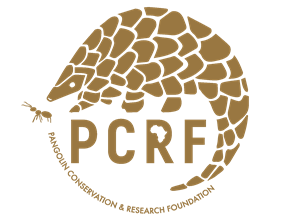
Pangolin Conservation and Research Foundation
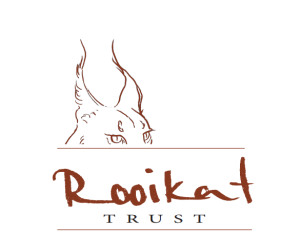
Rooikat Trust
Activities
Conservation and guidelines
The NPWG has drafted the National Pangolin Conservation Management Plan for 2021- 2026. Additionally, a handbook was developed by NARREC for first responders including MEFT and law enforcement officers which includes guidelines in the handling of confiscated pangolins and their parts. View the First Responders Manual in English and in Portuguese.
These guidelines include:
- Pangolin confiscation flowchart
- Live confiscated pangolin flowchart
- Initial Report Form
- Biometrics Form
- Pangolin seizure and translocation log
- Transport guidelines
- Release and release site guidelines
- Biometrics card, and Wildlife assessment card
Capacity building
The NPWG has provided resources and training for first-responders in the regions most affected by the illegal wildlife trade. These regions have received specially designed boxes to transport pangolin safely. the regional offices have the handbook of guidelines and the First Responders Manual in English and in Portuguese. A training curriculum was developed and materials were distributed during training workshops which reached over 100 front-line officers. Officers who passed the course received a certificate of achievement which gives credibility to their testimony in pangolin court cases.
Veterinary capacity
A network of veterinary clinics across six regions has been established to provide health assessments and emergency care for live confiscated pangolins. All clinics were offered a training seminar in emergency first-response. Additionally, a veterinary emergency fund has been setup with an initial amount of N$40,000 contributed by the Namibian Chamber of Environment and Rooikat Trust.
Research
A distribution map was created from a sightings survey (which is still open for reporting any pangolin sightings), as well as game count and event book records from national parks and conservancies. Through collaboration, the first confiscated pangolin was fitted with a GPS/SAT transmitter for post-release monitoring under the Pangolin Conservation and Research Project. You can read more about this pangolin’s story here. The Namibian Chamber of Environment has offered to sponsor two local MSc Students to further research the feeding ecology of pangolins and impacts of electric fencing.
Awareness
Posters have been created, including on the pangolin reward scheme and on pangolin biology and ecology. See the Resources tab for downloadable files. Members of the NPWG regularly issue media releases, radio interviews, popular articles and public talks to help educate and spread awareness. See the News, Articles & Interviews tab for examples.
Events
- Let Every Scale Count – art exhibition at the Namibian Arts Association from 7 June 2022
You can read more about some of our major accomplishments in this blog article.
News, Articles & Interviews
As well as news and blog articles in the national and international media, members of the NPWG regularly issue media releases, radio interviews, popular articles and public talks to help educate and spread awareness.
Wildlife crimes news
News articles relating to crimes involving pangolins can be found on the eLibrary Wildlife Crimes Article Archive.
News articles
- The Namibian, 26 March 2020 – Namibia’s Pangolins – What do we Actually Know?
- Namibia University of Science and Technology, 6 March 2020 – For the love of pangolins, student studies this rare mammal
- Namibian Sun, 18 February 2019 – Pangolin saving scheme paying off
- Namibian Sun, 21 February 2018 – No pangolins, no grass
- Namibian Sun, 13 October 2017 – Reward for info on pangolin poachers
- The Namibian, 16 February 2017 – Harsh measures to protect the pangolin
- New Era, 14 February 2013 – International Pangolin Day
- The Namibian, 21 April 2011 – Pangolins endangered by international trade
Blog posts
- Conservation Namibia, 20th February, 2021 – Namibian Pangolin Working Group: collaboration for conservation success and World Pangolin Day
- Conservation Namibia, 29th August, 2020 – From facing certain death to contributing to science – a pangolin’s tale
- Travel News Namibia, Summer 2018/19 – The plight of the pangolin
Interviews
- Venture Media – Celebrating World Pangolin Day 2021. Interview with Kelsey Prediger
- NCE and MYD Earth Show, 2018 – Interview with Maria Diekmann and Chris Brown
Resources

Educational comic book on the plight of the Temminck’s ground pangolin
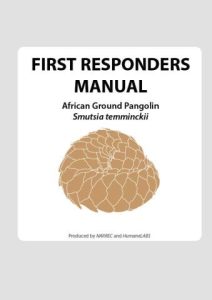
First Responders Manual – African Ground Pangolin
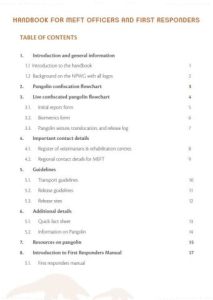
Handbook for MEFT officers and first responders
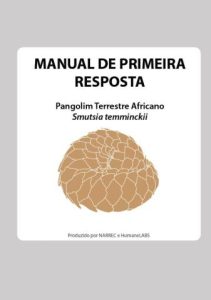
Manual de Primeira Resposta – Pangolim Terrestre Africano

Ministry of Environment, Forestry and Tourism career guide, 2021
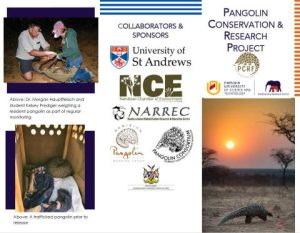
Pangolin Conservation & Research Project leaflet

Pangolins in Namibia ecology poster
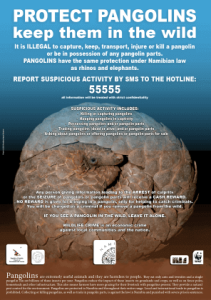
Protect pangolins poster
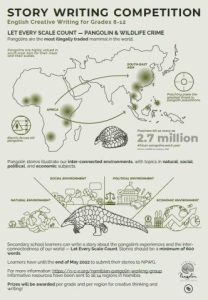
Story writing competition: English creative writing for grades 8 – 12
Beck A. 2009. Electric fence induced mortality in South Africa. University of the Witwatersrand. MSc Thesis. Download this resource from the EIS eLibrary
Lee ATK, Macray MB, Ryan PG, Alexander GJ. 2021. Tortoise mortality along fence lines in the Karoo region of South Africa. Journal for Nature Conservation 59. https://doi.org/10.1016/j.jnc.2020.125945. Download this resource from the EIS eLibrary
Pietersen DW, McKechnie AE, Jansen R. 2014. A review of the anthropogenic threats faced by Temminck’s ground pangolin, Smutsia temminckii, in southern Africa. South African Journal of Wildlife Research 44(2) 167-178. Download this resource from the EIS eLibrary
How can you help?
Please report suspicious activity to the hotline: SMS 55555
Suspicious activity includes:
- Killing or capture of pangolins
- Keeping pangolins in captivity
- Possessing pangolin and/or pangolin parts
- Trade in pangolins (dead or alive) and pangolin parts
- People asking about pangolins or offering pangolins or pangolin parts for sale (including on social media)
Spread awareness!
Share with others what you have learned to raise awareness on why it is important to protect pangolins. If you see a pangolin, appreciate its presence. Never tell others about a location where a pangolin has been seen.
Contact
Namibian Pangolin Working Group
Report suspicious activity
Send an sms to the hotline: 55555
First responders hotline
| Namibia: | +264 81 413 2214 |
| Angola: | +244 912 226938 |
| Moçambique: | +258 84 322 0837 |
